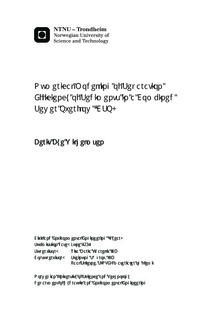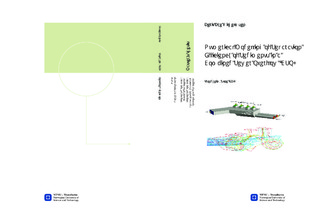| dc.contributor.advisor | Ugarelli, Rita Maria | nb_NO |
| dc.contributor.advisor | Sægrov, Sveinung | nb_NO |
| dc.contributor.advisor | Skjetne, Paal | nb_NO |
| dc.contributor.author | Wilhelmsen, Berit Bye | nb_NO |
| dc.date.accessioned | 2014-12-19T12:32:07Z | |
| dc.date.available | 2014-12-19T12:32:07Z | |
| dc.date.created | 2012-11-08 | nb_NO |
| dc.date.issued | 2012 | nb_NO |
| dc.identifier | 566313 | nb_NO |
| dc.identifier | ntnudaim:7238 | nb_NO |
| dc.identifier.uri | http://hdl.handle.net/11250/242277 | |
| dc.description.abstract | Combined sewer overflows (CSOs) are a part of the combined storm water and foul sewer system. CSOs should protect the downstream sewer system against overloading during heavy rainfall and snow melting. This report investigates how three-dimensional computational fluid dynamics (CFD) can be applied to evaluate the quality performance of combined sewer overflows (CSOs).Separation efficiency is a performance indicator defined as the fraction of sediments that are treated and not overflowing. Emissions from poorly constructed CSOs have a harmful impact on receiving water quality. Predicted increase in rainfall in the northern hemisphere due to climate change is enhancing stresses imposed on these structures. EU established the Water Framework Directive (WFD) in 2000 to ensure good ecological and chemical quality for receiving streams and lakes. To meet this standard, a reduction in emissions of pollutants is required through improvement of separation efficiency of CSOs. Numerical modelling creates new opportunities for detailed analyzes of existing and new structures as such tools where not available when the first CSOs where built.In this report, the assessment of a CSO with CFD is presented in the context of a geometry from Århus. The CSO is one of the case studies in the EU project PREPARED Enabling Change, which aims to adapt Europe s water supply and sanitation systems to climate change. It is a complex device with one inlet, four overflow chambers and two outlet pipes.Prior to the modelling, a literature review was carried out to identify the characteristics of combined sewage. The purpose was to determine what particles that should be modelled and find appropriate boundary conditions.The sewer quality showed large variations dependent on flow rate, locations inside the system and between different systems. The combined sewage consists of a mixture of organic and inorganic material and no unique relationship between density and particle size could therefore be found. A wide range of sediments with size 100m - 5mm and densities 1002kg/m3, 1170kg/m3, 1400kg/m3, 1720kg/m3, 2000kg/m3 and 2650kg/m3 were therefore selected to represent sewer sediments in the numerical model.At the bed of the CSO a criteria was needed to determine if a particle settled or was suspended in the fluid. A bed shear stress (BSS) boundary condition was found to be appropriate. The shear stress at the bed was compared to a critical value specified by the user. A study by Berg (1988) showed that the critical value for settling of particles in a combined sewer with sand traps was 1.0Pa.The numerical modelling was done with the commercial software FLUENT. Analyzes where carried out for two scenarios; (1) filling of the CSO with throughflow to the treatment plant, and (2) during overflow to receiving waters. Three velocities was used (0.3m/s, 0.5m/s and 0.7 m/s) to test the influence of velocity on the separation efficiency.The paper demonstrates how the discrete phase model (DPM) can be utilized to predict particle trajectories and final destination of particles and how this can be used to calculate separation efficiency. The conclusion is that the particle tracking routine was found to be suitable for analyzes of sediment transport and separation efficiency. Overall the CSO in Århus showed a good separation efficiency higher than 50% for all velocities. The exception was sand particles with size 0.1mm and organic material withdensity 1170kg/m3 and diameters up to 0.5mm. The results showed that velocity had a strong influence on separation efficiency and flow streamlines on the distribution of particles on the different overflows. It was crucial to define appropriate boundary conditions as it has a significant effect on the result. Difference in separation efficiency for different types of particles was most significant during slow flow conditions. A references to previous work has shown that the particle tracking routine probably overestimates the separation efficiency for high velocities (Stovin & Saul, 1998). In future work the results from Århus should be compared with measurements, to determine if this is the case for the Århus results as well.CFD modelling in combination with modern measurement techniques provide great opportunities for optimization of CSOs. The intention is that this can serve as a pilot project for future research and work with adaption of CSOs under climate change. | nb_NO |
| dc.language | eng | nb_NO |
| dc.publisher | Institutt for vann- og miljøteknikk | nb_NO |
| dc.subject | ntnudaim:7238 | no_NO |
| dc.subject | MIBYGG Bygg- og miljøteknikk (2 årig) | no_NO |
| dc.subject | Vannforsynings- og avløpsteknikk | no_NO |
| dc.title | Numerical Modelling of Separation Efficiency of Sediments in a Combined Sewer Overflow (CSO) | nb_NO |
| dc.type | Master thesis | nb_NO |
| dc.source.pagenumber | 80 | nb_NO |
| dc.contributor.department | Norges teknisk-naturvitenskapelige universitet, Fakultet for ingeniørvitenskap og teknologi, Institutt for vann- og miljøteknikk | nb_NO |

